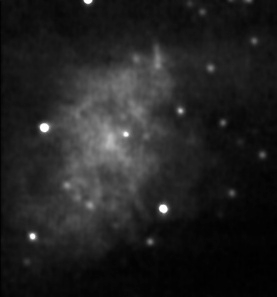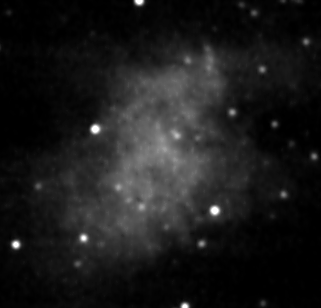
MEASURING AN OPTICAL PULSAR LIGHT CURVE
USING A STROBING TECHNIQUE
FEEDBACK FROM QCUIAG INTERNATIONAL CONFERENCE Q-2004
The results of this project were presented at the QCUIAG conference in February 2004. A question was asked concerning variations in the appearance of the nebulosity between the images showing the pulsar on and off, taken on the 23rd March 03.
There are indeed subtle differences as can be seen in this animated gif (each frames is composite of 50 frames from the original 200 frame avi)
Note that to bring out the changes in the pulsar more clearly, an unsharp mask has been applied to the brighter stars in this image, which includes the pulsar and its companion. This exagerates their brightness against the nebula.

It was suggested at the conference that these apparent variations in the nebulosity might be caused by the radiation from the pulsar as it sweeps through the nebula. This can however be discounted as the nebula is several light years across and the influence of any one 33msec pulse would only be on a very thin shell too small to resolve.
The issue is of some importance however as it could indicate some sort of bias between the two sets of exposures, which might influence the apparent detection of the pulsar.
To investigate the phenomenon further, I have taken 4 random sets of 50 exposures from the original 200 frame avi and made them into a similar 4 frame animated gif
(No unsharp masking has been applied to these images so the brightness of the pulsar and companion are correct relative to the nebula)

Similar variations can be seen in the nebulosity, though of course the flashing on and off of the pulsar is no longer evident. The conclusion is therefore that the variations in the appearance of the nebula are random in nature and not linked to the flashing of the pulsar.
Possible causes are random variations in camera noise, skyglow, seeing and transparency. It is perhaps not surprising, since although the individual exposures are 10sec in length, light from the nebulosity is only collected for a third of this time, putting the nebula close to the limits of detection for the camera in a single frame. The stacking of 50 frames will have reduced random effects by a factor of 7 (ie sqrt 50) but some variations are clearly still present.
19th March 2004